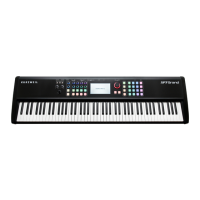47
7-2 Input 1, 2
Chapter 7
Chapter 7. Audio Mode
Each Input page features the same set of tabs govern-
ing each channel’s operation: Input, Dynamics (Dyn),
Parametric EQ (P.EQ), Simulation/Wah (Mod/Wah),
Delay/Tremolo (Dly/Trm), and Mix.
7-2-1 Input
The Input tab consists of controls for Gain, Lo-Cut filter and a Noise Gate.
Gain - Sets the amount of post input gain feeding into the input processing chain.
Lo-Cut - When enabled, this engages a gentle high-pass filter that reduces unwanted low frequencies.
Noise Gate Enable - This turns the noise gate on (green) and off (red).
Noise Gate Threshold - Sounds below the Threshold value are completely suppressed. Signals louder than the
Threshold, open the gate and are audible.
Noise Gate Release - This sets the time it takes for the gate to close once sound levels drop below the threshold.
Higher values allow for a slower/smoother action while lower values cause the gate to close more quickly.
For details on the following effects tabs and their parameters, please refer back to the earlier noted sections:
7-2-2 Dyn (Dynamic)
see pg 38 (section 5-1-1)
7-2-3 P.EQ (Parametric Equalizer)
The EQ section is a 4-band parametric. With each band,
you can choose from 7 EQ types using the selector tab
at the top of each band: LPF 6dB, LPF 12dB, LowShelf,
Peak/Notch, HighShelf, HPF 6dB and HPF12dB.
For each EQ type (excluding the LPF/HPF) you can set
the frequency (Freq), quality factor (Q), and gain (Gain).

